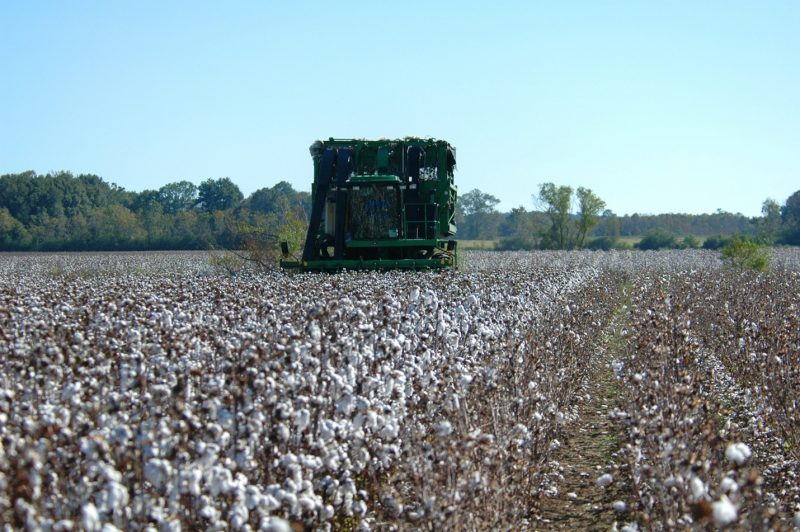Ramdeo “Andy” Seepaul, Ethan Carter, Ian Small, and Cheryl Mackowiak, UF/IFAS North Florida Research and Education Center
Cotton production in Florida’s Panhandle presents a unique set of challenges: light, sandy soils, variable rainfall, and diverse field conditions. One of the most critical decisions growers face each season is how much nitrogen (N) to apply, when to apply it, and what form to use. Effective N management can be the difference between profitability and falling short of yield goals. To better understand current N management practices and identify opportunities for improvement, we conducted a targeted grower survey in 2024 across seven Panhandle counties.
–
Survey Overview
We gathered responses from 12 farmers, most of whom were in Jackson County, Florida’s leading cotton-producing county. Other participants farmed in Calhoun, Escambia, Santa Rosa, Okaloosa, Jefferson, and Washington counties. Farm sizes ranged from under 100 acres to more than 2,000 acres of cotton. Despite this diversity, several consistent themes emerged regarding how N management is shaped by irrigation access, field conditions, and yield expectations.
–
Irrigation Drives Nitrogen Use and Yield
A key finding from the survey was the strong relationship between irrigation, N application rates, and yield outcomes. Farmers with irrigated fields, primarily in Jackson County, tended to apply higher N rates and reported higher yields. In contrast, dryland producers, typically used lower N rates and focused more on efficiency and risk management than top yields.
Irrigation allows for greater flexibility in adjusting N applications in response to crop needs throughout the season. Farmers without irrigation often adopt more conservative strategies, emphasizing efficient input use over maximizing output. These insights highlighted irrigation as a key enabler of intensive N management in the Panhandle cotton.
–
How Farmers Determine Nitrogen Rates
When asked how they determine N application rates, farmers most frequently cited yield goals, followed by crop nutrient removal, soil testing, and consultation with crop advisors or extension specialists. Fewer participants reported using plant tissue testing or decision support tools.
Split N applications were common, with most growers applying N in two or three stages. A typical three-way split included 60 pounds early in the season, followed by two later applications of 45 pounds each. These practices reflect an effort to align nutrient supply with crop demand, reducing potential losses and improving efficiency.

Researchers assess cotton growth and nitrogen status in a cotton field in the Florida Panhandle using field measurements and observational tools. Real-time sensing technologies support nitrogen decisions tailored to crop needs, enhancing efficiency and yield potential. Photo Credit: UF/IFAS Photo Archive
–
Fertilizer Sources and Application Methods
Growers used a range of N sources. Ammonium sulfate and urea with inhibitors were the most common, followed by coated urea, UAN, and ammonium nitrate. Broadcast and top-dress were the dominant application methods, although some growers used injection systems or fertigation through pivots. Side-dress and banded applications were less frequently reported. The choice of fertilizer form and application method often depended on available equipment, field layout, and whether irrigation was present.
–
Use of Stabilizers and Monitoring Tools
Several respondents reported using N stabilizers such as NutriSphere-N® to improve N retention and reduce volatilization or leaching. When monitoring crop N status, most relied on visual cues, followed by petiole sampling and plant maturity stage. Visual assessment remains a key decision trigger for in-season adjustments.
–
Broader Nutrient Management Practices
In addition to N, most growers applied phosphorus (P₂O₅) at 40–60 lbs/acre and potassium (K₂O) at 90–130 lbs/acre. Sulfur applications typically ranged from 15–25 lbs/acre, and boron was often applied at 1–2 lbs/acre. These nutrients are critical for supporting boll development and fiber quality, especially in nutrient-poor, sandy soils that are common in the region.
–
Adoption of New Tools and Practices
Many farmers reported recent adoption of practices such as split applications, cover crops, variable rate fertilization technology, and controlled-release fertilizers. A few had experimented with organic sources. Looking ahead, growers expressed strong interest concerning in-field petiole N testing, followed by aerial spectral analysis and smart agriculture decision tools, especially those available through cost-share conservation programs.
–

Achieving high cotton yields requires proper nitrogen management, including the right rate, source, timing, and placement, especially when combined with irrigation. This harvested field in Florida’s Panhandle reflects the results of those critical decisions. Photo Credit: UF/IFAS Photo archive
–
Conclusions and Next Steps
This survey offered a snapshot of how Panhandle cotton growers currently manage N in real-world scenarios. The results highlight irrigation as a key determinant of N strategy and yield outcomes. They also reveal a strong interest in technologies that support flexible, responsive nutrient management.
Moving forward, on-farm trials and modeling tools should be used to validate and refine these insights. Tailored recommendations that account for irrigation status, field variability, and grower experience will help fine-tune N management strategies in the future, boosting both efficiency and profitability in Florida’s Panhandle cotton production systems.
- Grower Survey Insights on Cotton Nitrogen Management in Florida’s Panhandle - July 18, 2025
- Florida Soils are an Indispensable Natural Resource - January 10, 2025
- Regenerative Agriculture: What it Means to You - June 21, 2024
